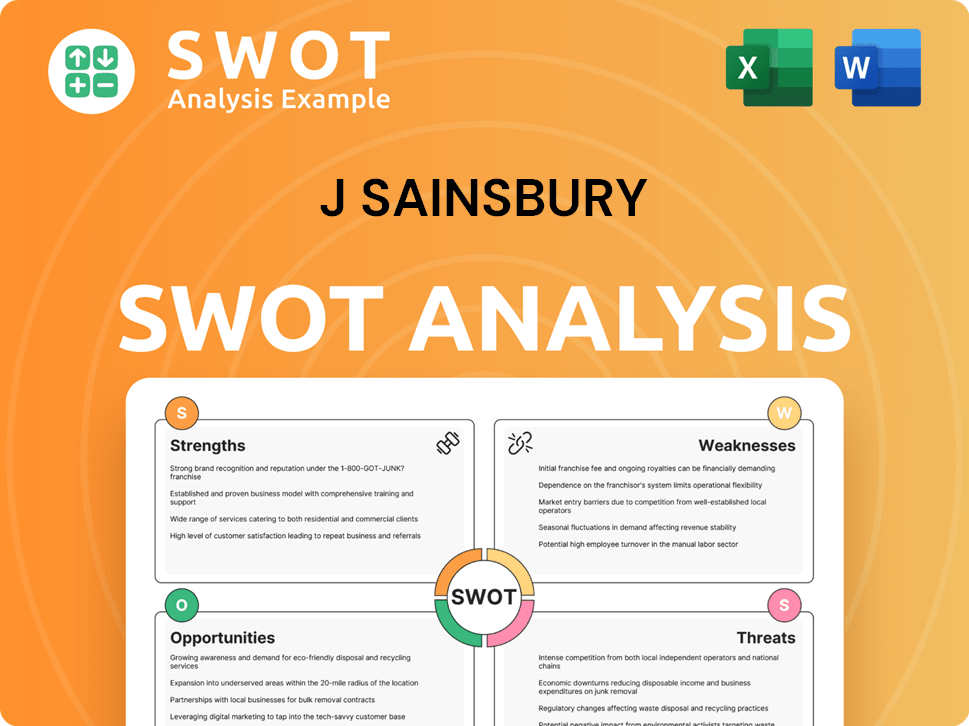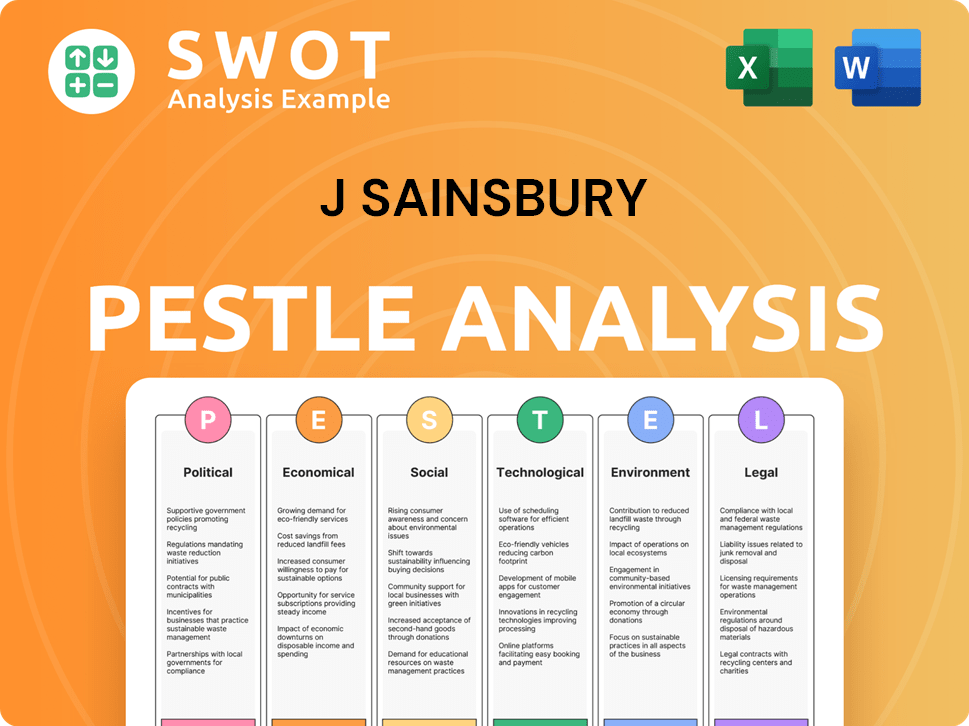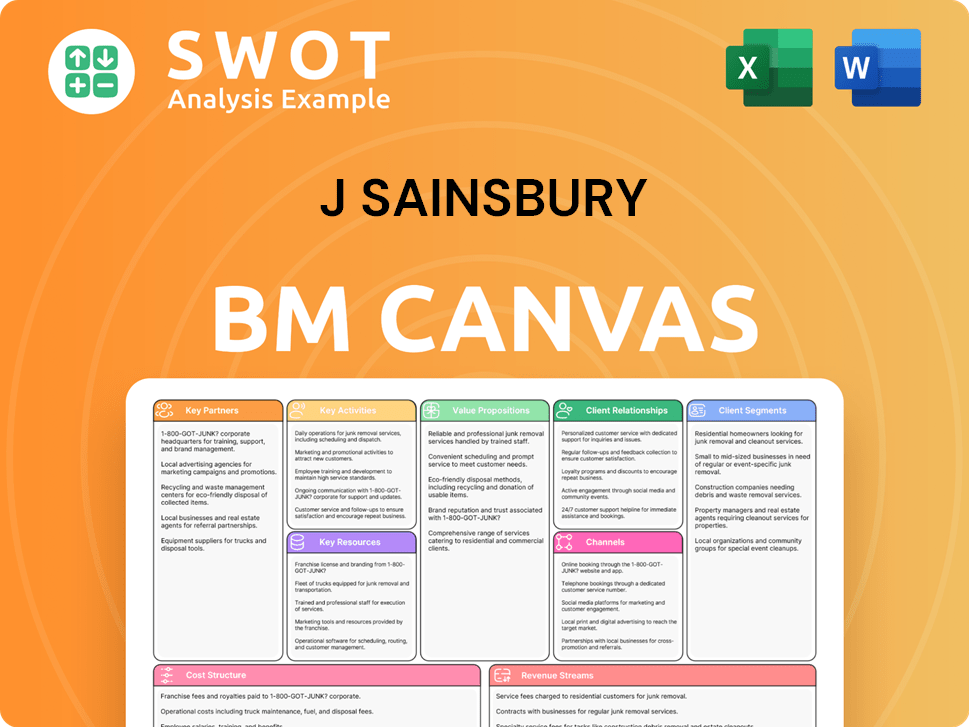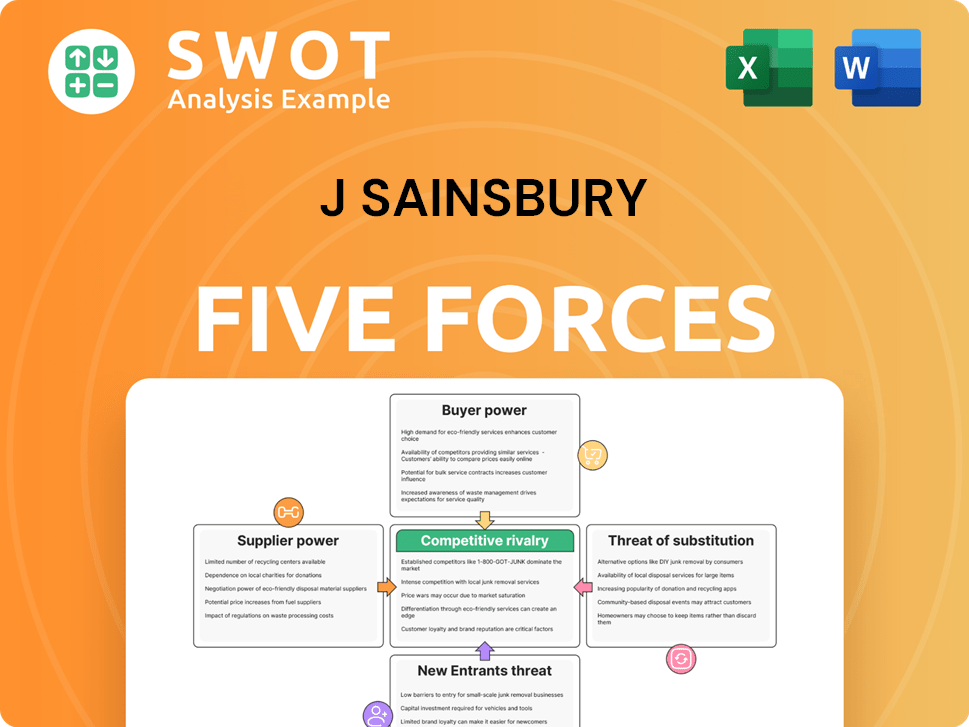J Sainsbury Bundle
How Does J Sainsbury Thrive in Today's Market?
J Sainsbury, a cornerstone of British retail for over 150 years, remains a powerful force in the grocery, general merchandise, and clothing sectors. This UK supermarket giant has consistently adapted to consumer shifts, maintaining its household name status. With its extensive network of stores and a robust online presence, understanding Sainsbury's operations is key to unlocking its potential.

Delving into the intricacies of the Sainsbury company reveals a complex interplay of factors driving its success. From its diverse product offerings, including fresh produce and clothing lines, to its financial services arm, Sainsbury's demonstrates a multifaceted approach. To gain a deeper understanding of its competitive advantages, market positioning, and future outlook, consider exploring a detailed J Sainsbury SWOT Analysis to uncover the strategies that shape this retail business.
What Are the Key Operations Driving J Sainsbury’s Success?
J Sainsbury, often referred to as Sainsbury's, creates and delivers value through its extensive retail network. It offers a wide range of products and services designed to meet diverse consumer needs. This includes fresh food, groceries, general merchandise (through Argos), and clothing (through Tu).
The company serves a broad customer base across the UK, from daily shoppers seeking convenience to those looking for a wider range of non-food items. Its operational processes are complex and highly integrated, encompassing sophisticated sourcing, efficient logistics, and multi-channel sales capabilities.
Sainsbury's leverages a robust supply chain to ensure product availability and freshness across its various store formats, including large supermarkets, smaller convenience stores, and its rapidly expanding online platform. The company's integrated retail model, particularly the synergy between its grocery business and Argos, enhances efficiency through cross-selling opportunities and shared logistical infrastructure.
Sainsbury's core offerings include fresh food, groceries, general merchandise (through Argos), and clothing (through Tu). These diverse product categories cater to a wide range of customer needs, from everyday essentials to non-food items.
The company serves a wide customer base across the UK. This includes daily shoppers seeking convenience and those looking for a broader range of non-food items. Sainsbury's caters to various demographics and shopping habits.
Operational processes are complex and highly integrated, encompassing sophisticated sourcing, efficient logistics, and multi-channel sales capabilities. Sainsbury's focuses on ensuring product availability and freshness.
The integrated retail model, particularly the synergy between its grocery business and Argos, enhances efficiency. Customers can collect Argos orders within Sainsbury's supermarkets, blurring the lines between traditional grocery and general merchandise retail.
Digital platforms, including e-commerce websites and mobile apps, are crucial sales channels, offering convenience and expanding its reach. Sainsbury's also emphasizes customer service, aiming to provide a seamless shopping experience across all touchpoints. Its core capabilities translate into customer benefits such as convenience, variety, and competitive pricing, while its scale and brand recognition provide a significant market differentiation. For more in-depth information about the company, consider reading about Owners & Shareholders of J Sainsbury.
Sainsbury's operational effectiveness is underpinned by its integrated retail model and robust supply chain. This allows for efficient cross-selling and shared logistical infrastructure, enhancing customer convenience and operational efficiency. The company continues to invest in its digital platforms to expand its reach and offer a seamless shopping experience.
- Supply Chain: Sainsbury's supply chain ensures product availability and freshness across its various store formats.
- Digital Platforms: E-commerce websites and mobile apps are crucial sales channels.
- Customer Service: Sainsbury's emphasizes a seamless shopping experience across all touchpoints.
- Market Differentiation: Scale and brand recognition provide significant market differentiation.
J Sainsbury SWOT Analysis
- Complete SWOT Breakdown
- Fully Customizable
- Editable in Excel & Word
- Professional Formatting
- Investor-Ready Format

How Does J Sainsbury Make Money?
J Sainsbury, often referred to as Sainsbury's, generates revenue through a variety of retail channels. The primary sources include grocery sales, general merchandise, and clothing, all contributing to its overall financial performance. Understanding these revenue streams is crucial for assessing the Sainsbury company's financial health and strategic direction.
The company's monetization strategies center on direct product sales, customer loyalty programs, and integrated services. These approaches, combined with a focus on e-commerce, aim to enhance customer engagement and drive revenue growth. Analyzing these strategies provides insights into how Sainsbury's adapts to evolving consumer preferences and market dynamics.
Sainsbury's reported total retail sales (excluding fuel) of £30.6 billion in the fiscal year ending March 2024. This figure underscores the significance of its retail operations, particularly its grocery sales, which form the core of its revenue. General merchandise and clothing sales also contribute substantially, with Argos playing a key role in non-food revenue.
Sainsbury's employs several strategies to generate revenue and enhance customer engagement. These include direct product sales, loyalty programs, and integrated services like 'Click & Collect'. The company's focus on e-commerce and digital platforms is also a key component of its monetization strategy.
- Grocery Sales: The largest revenue stream, driven by sales from supermarkets and convenience stores.
- General Merchandise: Sales through Argos, offering a wide range of non-food products.
- Clothing Sales: Revenue generated by the Tu clothing brand, available in-store and online.
- Loyalty Programs: The Nectar card incentivizes repeat purchases and provides valuable customer data.
- Click & Collect: Enables customers to order online and pick up in-store, driving footfall.
- Financial Services: Sainsbury's Bank offers credit cards, loans, and insurance products.
- E-commerce: Significant investment in digital platforms and delivery infrastructure to capture online market share.
For further insights into Sainsbury's strategic direction, consider exploring the Growth Strategy of J Sainsbury.
J Sainsbury PESTLE Analysis
- Covers All 6 PESTLE Categories
- No Research Needed – Save Hours of Work
- Built by Experts, Trusted by Consultants
- Instant Download, Ready to Use
- 100% Editable, Fully Customizable

Which Strategic Decisions Have Shaped J Sainsbury’s Business Model?
The evolution of J Sainsbury, often referred to as Sainsbury's, has been marked by significant milestones and strategic shifts. A pivotal moment was the acquisition of Argos in 2016, which broadened its revenue streams beyond its core grocery business. This strategic move allowed Sainsbury's to integrate Argos's strong online presence, enhancing its multi-channel retail strategy and customer reach. The company continuously invests in its store network, optimizing its portfolio with new convenience stores and refurbishing existing supermarkets to improve the customer experience.
Sainsbury's has navigated challenges such as intense competition within the UK grocery market, particularly from discounters like Aldi and Lidl, as well as broader economic pressures, including inflation and supply chain disruptions. The company has responded by focusing on value, improving its own-brand offerings, and enhancing operational efficiencies. These efforts are part of a broader strategy to maintain its market position and adapt to changing consumer behaviors and economic conditions. The company's approach involves a balance of cost management, innovation, and customer-centric initiatives.
Sainsbury's competitive advantages include strong brand recognition and a legacy of trust among British consumers. Its extensive store footprint provides a significant physical presence, complemented by a robust online delivery network. The integration of its various retail formats, particularly the synergy between Sainsbury's and Argos, offers a unique proposition that competitors struggle to replicate. Furthermore, the Nectar loyalty program provides valuable customer insights, enabling personalized offers and strengthening customer retention. The company continues to adapt to new trends, such as the growing demand for sustainable products and convenient online shopping. Its ongoing strategic initiatives often focus on leveraging technology to enhance the customer experience, optimize supply chains, and further integrate its diverse business segments to maintain its competitive edge.
The acquisition of Argos in 2016 was a major strategic move. This expanded Sainsbury's offerings beyond groceries. Continuous investment in store networks and optimizing the portfolio are also key.
Focusing on value and improving own-brand offerings is crucial. Enhancing operational efficiencies is another key strategy. Adapting to changing consumer behaviors and economic conditions is also essential.
Strong brand recognition and trust are significant advantages. Extensive store footprint and a robust online delivery network are also key. The integration of retail formats, like Sainsbury's and Argos, is a unique proposition.
Sainsbury's is adapting to the growing demand for sustainable products. They are also focusing on convenient online shopping. Leveraging technology to enhance the customer experience is a priority.
In 2024, Sainsbury's continues to focus on its core strategy. This includes enhancing its value proposition and improving its online services. The company is also investing in its supply chain to improve efficiency.
- Sainsbury's is focusing on expanding its online grocery delivery services.
- The company is working to improve its sustainability initiatives.
- They are also focusing on their Nectar loyalty program.
- Sainsbury's is constantly adapting to market changes.
For further insights into Sainsbury's growth strategies, consider reading Growth Strategy of J Sainsbury.
J Sainsbury Business Model Canvas
- Complete 9-Block Business Model Canvas
- Effortlessly Communicate Your Business Strategy
- Investor-Ready BMC Format
- 100% Editable and Customizable
- Clear and Structured Layout

How Is J Sainsbury Positioning Itself for Continued Success?
J Sainsbury (Sainsbury's) holds a significant position in the UK retail sector, specifically within the grocery store market. It competes with major players like Tesco, Asda, and Morrisons, alongside growing discounters. Sainsbury's benefits from its established brand reputation and the Nectar loyalty program. Its operations are primarily focused within the UK market, where it maintains a strong national presence.
The future outlook for Sainsbury's involves strategic initiatives aimed at strengthening its core food business, integrating its Argos and Tu brands, and enhancing digital capabilities. The company is focused on providing value, innovating its product offerings, and improving operational efficiency. Sainsbury's aims to maintain its competitive standing in the evolving UK retail landscape by adapting to changing consumer needs and leveraging its integrated retail model.
Sainsbury's is a leading UK supermarket, competing with Tesco, Asda, and Morrisons. It has a strong brand reputation and a well-established customer loyalty program, Nectar. The company primarily operates within the UK market, with a broad national presence.
Sainsbury's faces risks from inflationary pressures affecting profit margins and consumer spending. Intense competition from discounters and online retailers also poses a threat. Regulatory changes and evolving consumer preferences, such as the demand for online shopping and sustainability, require continuous adaptation.
Sainsbury's plans to strengthen its core food business, integrate Argos and Tu brands, and enhance digital capabilities. The company focuses on value, product innovation, and operational efficiency. Leadership emphasizes cost savings and leveraging technology to improve customer experience.
Sainsbury's is focused on its 'Save Money, Live Better' campaign to provide better value. The company aims to expand its online presence and leverage its integrated retail model. These strategies are designed to meet evolving consumer needs and maintain a competitive edge. Read more about the Brief History of J Sainsbury.
In recent financial reports, Sainsbury's has shown resilience amidst market challenges. Key performance indicators such as sales figures and profit margins reflect the company's ability to adapt. The company's investments in digital infrastructure and supply chain optimization have been crucial.
- Sainsbury's continues to focus on cost management and efficiency improvements.
- The company's online sales and digital initiatives are a growing part of its revenue.
- Investments in sustainability and ethical sourcing are increasing.
- Customer loyalty programs, like Nectar, remain a key driver of sales.
J Sainsbury Porter's Five Forces Analysis
- Covers All 5 Competitive Forces in Detail
- Structured for Consultants, Students, and Founders
- 100% Editable in Microsoft Word & Excel
- Instant Digital Download – Use Immediately
- Compatible with Mac & PC – Fully Unlocked

Related Blogs
- What are Mission Vision & Core Values of J Sainsbury Company?
- What is Competitive Landscape of J Sainsbury Company?
- What is Growth Strategy and Future Prospects of J Sainsbury Company?
- What is Sales and Marketing Strategy of J Sainsbury Company?
- What is Brief History of J Sainsbury Company?
- Who Owns J Sainsbury Company?
- What is Customer Demographics and Target Market of J Sainsbury Company?
Disclaimer
All information, articles, and product details provided on this website are for general informational and educational purposes only. We do not claim any ownership over, nor do we intend to infringe upon, any trademarks, copyrights, logos, brand names, or other intellectual property mentioned or depicted on this site. Such intellectual property remains the property of its respective owners, and any references here are made solely for identification or informational purposes, without implying any affiliation, endorsement, or partnership.
We make no representations or warranties, express or implied, regarding the accuracy, completeness, or suitability of any content or products presented. Nothing on this website should be construed as legal, tax, investment, financial, medical, or other professional advice. In addition, no part of this site—including articles or product references—constitutes a solicitation, recommendation, endorsement, advertisement, or offer to buy or sell any securities, franchises, or other financial instruments, particularly in jurisdictions where such activity would be unlawful.
All content is of a general nature and may not address the specific circumstances of any individual or entity. It is not a substitute for professional advice or services. Any actions you take based on the information provided here are strictly at your own risk. You accept full responsibility for any decisions or outcomes arising from your use of this website and agree to release us from any liability in connection with your use of, or reliance upon, the content or products found herein.